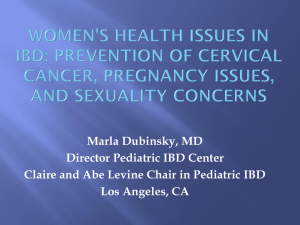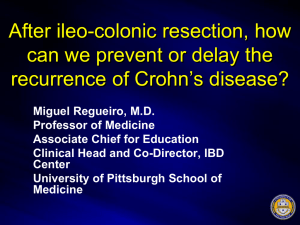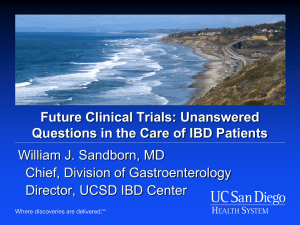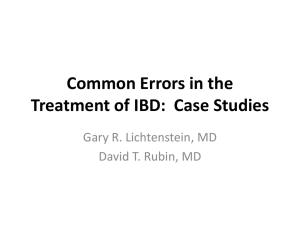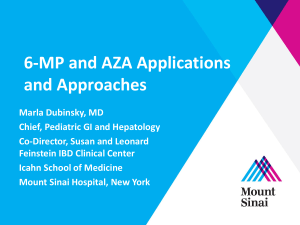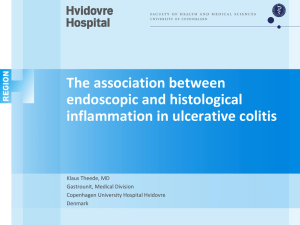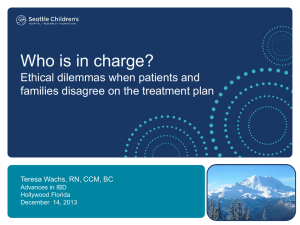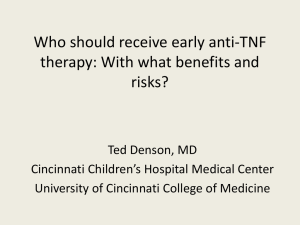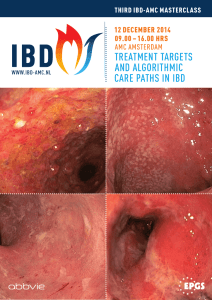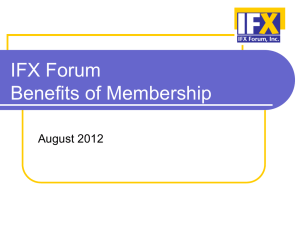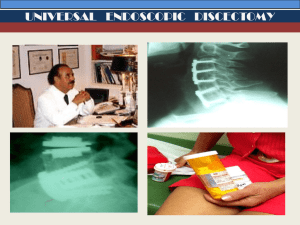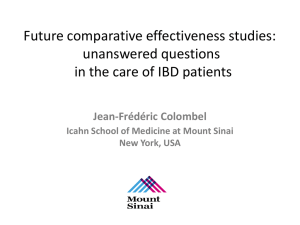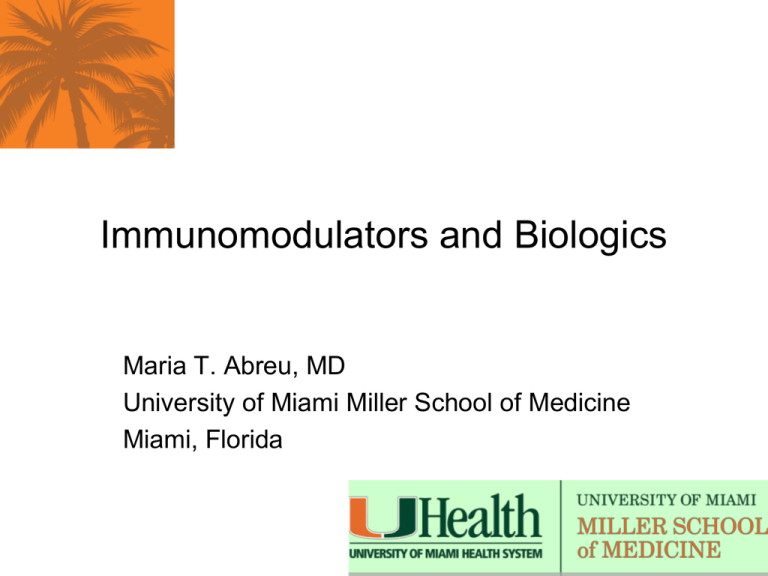
Immunomodulators and Biologics
Maria T. Abreu, MD
University of Miami Miller School of Medicine
Miami, Florida
Management of Post-Operative
Recurrence of IBD
David T. Rubin, MD, AGAF
Associate Professor of Medicine
Co-Director, Inflammatory Bowel Disease Center
University of Chicago Medicine
Induction of
remission
IBD
Maintenance of
remission
Maintenance
of remission
off steroids
and/or
Mucosal
healing
(histology)
What do we know: Guiding
principles
Combination therapy is better than
monotherapy
Early therapy is better than late therapy
(esp Crohn’s disease)
Well timed surgery is ok
Indications for Surgery
Crohn’s disease:
Obstruction
Medically refractory disease
Hemorrhage/transfusion requirements
High grade dysplasia or cancer
Growth delay
Fistula/abscess
Ulcerative colitis:
Medically refractory disease/fulminant disease
High grade dysplasia or cancer
Hemorrhage/transfusion requirements
Perforation
First-line Biologic Agents for
the Treatment of CD
Infliximab
Adalimumab
Certolizumab
Pegol
VL
No Fc
VH
CH1
PEG
IgG1
Chimeric monoclonal
antibody (75% human
IgG1 isotype)
Mouse
Human
PEG, polyethylene glycol.
IgG1
Human recombinant
antibody (100% human
IgG1 isotype)
PEG
Humanized Fab’
fragment (95% human
IgG1 isotype)
SONIC
•Moderate-to-severe CD in patients with no prior
exposure to biologic agents or immunomodulators
•Excluded intermediate TPMT activity
•Average disease duration 2.3 years
AZA 2.5mg/kg
IFX 5mg/kg
IFX + AZA
• 1° endpoint: Induction + maintenance of steroid-free
remission
• 2° endpoint: Mucosal healing
9
SONIC
Clinical Remission
Without Corticosteroids at Week 26
Primary Endpoint
Proportion of Patients (%)
100
p<0.001
80
p=0.009
p=0.022
57
60
45
40
30
20
0
52/170
AZA + placebo
75/169
IFX + placebo
96/169
IFX+ AZA
Colombel, J.F., et al., N Engl J Med. 362(15): p. 1383-95.
Cumulative Probability of Surgery
in Crohn’s Disease
100
Patients* (%)
80
60
40
20
0
0
5
10
15
20
25
Years After Onset
Mekhjian HS et al. Gastroenterol. 1979;77(4 pt 2):907-913.
30
35
Preoperative Corticosteroids Increase
Risk of Postoperative Complications in IBD
Minor
Complications
Major
Complications*
3.69 (1.24–10.97)
5.54 (1.12–27.26)
CS <20 mg
2.56 (0.68–9.61)
6.28 (0.97–40.36)
CS 30–40 mg
3.12 (0.93–10.49)
5.87 (0.90–38.23)
CS >40
9.16 (1.51–55.42)
18.94 (1.72–207.34)
6-MP/AZA
1.68 (0.65–4.27)
1.2 (0.37–3.94)
6-MP <1.5 mg/kg
1.49 (0.56–3.98)
1.12 (0.32–3.93)
6-MP>1.5 mg/kg
4.50 (0.46–44.51)
1.89 (0.32–3.93)
CS
*Major complications include sepsis, pneumonia, peritonitis, abscess, wound infection
• 159 IBD patients (71 UC, 88 CD) undergoing
elective bowel surgery
CS, corticosteroids; 6-MP, 6-mercaptopurine; AZA, azathioprine
Aberra FN et al. Gastroenterology. 2003;125:320.
TNF Use Prior to Surgery
• Postoperative infections
– CD1: Mayo Clinic
• 52 IFX vs 218 no IFX
• OR 0.9 (95% CI
0.4–1.9)1
– UC2: Mayo Clinic
• 47 IFX vs. 254 no IFX
• OR 2.7 (95% CI 1.1–6.7)
– UC3: Cleveland Clinic
CD
?
UC
• Pelvic sepsis
• 46 IFX vs. 46 no IFX
• OR 13.8 (1.8–105)
IFX, infliximab; OR, odds ratio; CI, confidence interval
1. Colombel JF et al. Am J Gastroenterol. 2004;99:878.
2. Selvasekar CR et al. J Am Coll Surg. 2007;204:956.
3. Mor IJ. Dis Col Rectum. 2008;51:1202.
Post-op Ileocecectomy is the Perfect
Opportunity for Prevention!
Health
Disease
Prevention
Symptomatic
Inflammation
Subclinical
Inflammation
Complications Disability
Prevention of
Complications
Prevention of
Symptomatic Disease
Prevention of
Relapse
Recurrence After Surgery
in Crohn’s Disease
100
N=89
Patients (%)
80
Survival without surgery
60
Survival without
laboratory recurrence
40
Survival without symptoms
20
Survival without
endoscopic lesions
0
0
1
2
3
4
5
Years
Rutgeerts P et al. Gastroenterol. 1990;99(4):956-963.
6
7
8
Risk Stratification for Recurrence in
Post-operative Crohn’s disease
Smoking
Perforating-type of
disease
Small bowel disease
Ileocolonic disease
Perianal fistulas
Duration of disease
Age
? Clear margins
? Length of resection
?Type of anastomosis
Greenstein AJ et al. Gut. 1988;29(5):588-592. Bernell O et al. Ann Surg. 2000;231(1):38-45. Bernell O et al. Br J Surg. 2000;87(12):1697-1701.
D'Haens GR et al. Gut. 1995;36(5):715-717. Lautenbach E et al. Gastroenterol.1998;115(2):259-267. Moskovitz D et al. Int J Colorectal Dis. 1999;14(45):224-226. Kono T et al. Dis Colon Rectum 2011 May;54(5):586-92.
The Neo-TI: The Rutgeerts’ Score
Patients should be scoped 6 months after surgery
to re-stratify risk
Rutgeerts 0
Rutgeerts 1
Rutgeerts 2
Normal ileal mucosa
<5 aphthous ulcers
>5 aphthous ulcers, normal
intervening mucosa
Ulceration
without normal
intervening
mucosa
Rutgeerts 3
Severe ulceration
with nodules,
cobblestoning, or
stricture
Rutgeerts 4
The neo-terminal ileum is not the anastomosis!
• Suture-related trauma
• Marginal ulcerations/ischemia
Symptoms after Crohn’s Surgery are Not
Always Inflammatory!
Symptom/Cause
Treatments
Post-operative pain
Limited analgesia, regional
anesthesia when possible
Anti-diarrheals
Post-resection “diarrhesis”
(rapid transit due to absence
of obstruction and muscular
hypertrophy)
Bile salts
Narcotic bowel
Bacterial overgrowth
Bile acid sequestrant
NO narcotics!
antibiotics
Medical Prevention of Clinical and Endoscopic
Recurrence of Crohn’s Disease
Clinical Recurrence
Endoscopic recurrence
Placebo
25% – 77%
53% - 79%
5 ASA
24% - 58%
63% - 66%
Budesonide
19% - 32%
52% - 57%
7% - 8%
52% - 54%
AZA/6MP
34% – 50%
42 – 44%
Infliximab
0%
9.1%
Nitroimidazole
Regueiro M. Inflamm Bowel Dis. 2009 Oct;15(10):1583-90.
Thiopurines for the prevention of postoperative
recurrence in Crohn’s disease: meta-analysis
Endoscopic
Peyrin-Biroulet L et al. Am J Gastroenterol. 2009 Aug;104(8):2089-96.
Clinical
Metronidazole/azathioprine combination
therapy for post-operative recurrence
– High risk pts (n=81) = (age <30, smokers, steroids <3 months, second
resection, perforated/abscess)
– N=40 metronidazole 250 mg TID 3 months + AZA 2–3 tabs
– N=41 metronidazole 250 mg TID 3 months + placebo
% patients with endoscopic
recurrence (>i2) post surgery
p=0.048
Placebo
80
69
p=0.11
60
Combination therapy
53
44
40
p=0.03
34
22
20
3.4
0
Month 3
Month 12
D'Haens GR et al. Gastroenterology. 2008 Oct;135(4):1123-9.
No lesions at Month 12
Post-operative Endoscopic Recurrence
Infliximab vs. Placebo
Infliximab (n=11)
Placebo (n=13)
90
80
% patients
70
60
50
Infliximab vs placebo
p=0.0006
40
30
20
10
0
1/11
11/13
Endoscopic Recurrence
Endoscopic Recurrence defined as endoscopic scores of i2, i3, or i4.
Regueiro M et al. 2009 Feb;136(2):441-50.e1; quiz 716.
Proposed Algorithm
for Prevention of
Post-Op Recurrence
in Crohn’s
Assess risk of recurrence
Low
Therapy?
Don’t
Know
Moderate
High
Start therapy
Start therapy
?
Metronidazole at discharge
4 weeks
Thiopurine +
MTX
Colonoscopy
at 6 months
i0-i1
i2-i4
Treatment
Follow up
4 weeks
TNF + IMM
Colonoscopy
at 6 months
Colonoscopy
at 6 months
i0-i1
i0-i1
i2-i4
Escalate
Rx
i2-i4
Change dose/
optimization
Colonoscopy
at 3-6 months
Ulcerative colitis
Early mucosal healing a favorable
prognostic factor in UC
Patients in Corticosteroid-free
remission %
100
ACT 1 and
ACT 2
Infliximab-treated patients
P<0.0001
80
Week 8 endoscopy
60
46
40
34
20
11
6.5
0
Week 30 (ACT 1 and 2)
Endoscopic Score 0 (n=120)
Endoscopic Score 1 (n=175)
Endoscopic Score 2 (n=114)
Endoscopic Score 3 (n=57)
Colombel JF et al. Gastroenterology. 2011 Jun 29. [Epub ahead of print].
Week 8
endoscopic score
Can Surgery for UC be Prevented?
Mucosal Healing and Time to Colectomy in Infliximab-Treated Patients
0 = NORMAL
1 = MILD
2 = MODERATE
3 = SEVERE
Colombel JF, Rutgeerts P, Reinisch W, et al. Gastroenterology. 2011 Oct;141(4):1194-201
Ulcerative Colitis: Ileo-pouch Anal
Anastomosis
Colectomy
Cuff/Anal
Transition zone
J pouch
Better Outcomes at
High Volume Hospitals
50
OR = 1.18 (0.99–1.41)
Percent
40
35.4
30
25.6
20
OR = 2.42 (1.26–4.63)
10
4.0
0.7
0
Mortality
Low volume
Complications
High volume
Kaplan GG et al. Gastroenterology. 2008;134:680.
“Complications” of the Ileal Pouch
Surgical/
Mechanical
- Afferent limb syn.
- Efferent limb syn.
- Strictures
- Leaks
- Fistulae
- Sinuses
- Abscess
- Adhesions
- Re-operation
Inflammatory/
Infectious
-Pouchitis
-Crohn’s dis.
-Cuffitis
-Small
bowel bacterial
overgrowth
-CMV
-C. difficile
-Polyps
Compliments of Bo Shen, MD
Functional
- Irritable
pouch syn.
- Pelvic floor
dysfunction
- Poor pouch
compliance
- Pseudoobstruction
Dysplasia/
Neoplasia
Systemic/
Metabolic
- Dysplasia
- Cancer
- Anemia
- Osteoporosis
- Vitamin B12
deficiency
- Malnutrition
- Fertility
- Sexuality
Risk Factors for Pouchitis
•
•
•
•
•
•
•
•
•
Extensive UC
Backwash ileitis
Primary sclerosing cholangitis
p-ANCA
NOD2/ IL-1 receptor antagonist
polymorphisms
Ex-smoker
NSAIDs
Arthralgias
Family history of Crohn’s disease
Fazio VW et al. Ann Surg. 1995 August; 222(2): 120–127; Schmidt CM et al. Ann Surg. 1998 May; 227(5): 654–665; J L Lohmuller et
al. Ann Surg. 1990 May; 211(5): 622–629; Fleshner P et al. Clin Gastroenterol Hepatol. 2007 Aug;5(8):952-8; quiz 887; Achkar JP et
al.Clin Gastroenterol Hepatol. 2005 Jan;3(1):60-6; Shen B et al. Am J Gastroenterol. 2005 Jan;100(1):93-101; Le Q et al. Inflamm
Bowel Dis. 2012 Mar 29 [Epub ahead of print]
Figure: http://www.webmd.com accessed May, 2012.
Management of Pouchitis
(endoscopic confirmation is preferred)
Pouchitis
Cipro or Metronidazole x 2 wks
Responded
Not Responded
Cipro or Metronidazole x 2 more wks
Infrequent
Relapse
Frequent
Relapse
Antbx-responsive
Pouchitis
Antbx-dependent
Pouchitis
Responded
Not Responded
Antbx-refractory
Pouchitis
Cipro+ Metronidazole
or Rifaximin or Tinidazole x 4 wks
Antibiotics prn
Probiotics or
Antibiotics
Not Responded
5-ASA/steroids/
Immunomodulators/Infliximab?
Can Pouchitis be Prevented?
Frequency of Pouchitis with Probiotic Prophylaxis
% cases with flare-up
100
P < 0.05
80
60
40%
40
20
10%
0
VSL3
N = 20
6 grams QD
x 12 months
Gionchetti P et al. Gastroenterol 2003 May;124(5):1202-9.
Placebo
N = 20
Key Take Home Messages
IBD
• Stratify patients for disease severity &
potential long-term complications
• Combination therapy better than
monotherapy for sick patients naïve to
both
• Low Absolute risk of IS or Biologic therapy
• Vaccines, DXAs and other health
maintenance issues will eventually be
used to measure quality
Risks of IBD Therapy
• Non-melanoma skin cancer (NMSC) associated
with current or past IS therapy
• No other solid tumors show clear association
with IS or anti-TNF therapy
• No clear signal that combination therapy leads
to higher risk than monotherapy
• HSTCL occurs AFTER 2 years of thiopurine
exposure
• Risk of PML after 2 years on natalizumab about
1 in 100 exposed patients
Management of Post-operative Recurrence
in IBD
• Know patient’s risk of recurrence
• Confirm endoscopic disease
• Ulcerative colitis
– Mucosal healing reduces risk of colectomy
– Assess risk of pouchitis
– Distinguish pouchitis/Crohn’s/pre-pouch ileitis
• Crohn’s disease (ileo-colonic anastomosis)
– Assess colonoscopic recurrence @ 6 months
– Prophylaxis vs re-treatment based on risks and
treatment history
– Subsequent clinical/endoscopic f/u not defined
Microscopic colitis
• Incidence appears to have stabilized
• Consider celiac disease if steatorrhea or
weight loss
• Consider drug-induced MC
• Treat with bismuth or budesonide
–
-Right dose and right duration
• Maintenance therapy with budesonide is
effective
Gut microbiota and IBS
• Microbiota in IBS:
– Differs from health & may contribute to
pathogenesis
– May lead novel diagnostic tests for IBS
– May select or predict response to IBS
treatments treatments
– Provide potential target in IBS
• Antibiotics, Probiotics, Therapeutic foods

